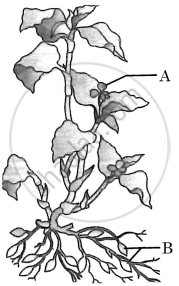Advertisements
Advertisements
प्रश्न

Observe the picture of Commelina plant bearing two types of flowers given above.
- Identify the two types of flowers labelled 'A' and 'B' in the picture. [1]
- Compare the two types of flowers with reference to: [2]
- Characteristic feature
- modes of pollination
- List any two 'out breeding devices' in flowering plants. Explain why do plants develop such devices. [1]
दीर्घउत्तर
उत्तर
-
- Chasmogamous
- Cleistogamous
- Comparing the two varieties of flowers with respect to:
- Characteristic Features: Chasmogamous flowers (type A) are often large and beautiful, with open petals that provide pollinators easy access to the reproductive organs. Cleistogamous flowers (type B) are often tiny, inconspicuous, and closed, with petals closely concealing the reproductive organs.
- Pollination modes: chasmogamous flowers (type A) rely on crosspollination, which is helped by pollinators such as insects, birds, and wind. These blooms attract pollinators by producing an abundance of nectar and pollen. Cleistogamous flowers (type B) pollinate themselves or reproduce autonomously. Because they remain closed, pollinators are less likely to visit them. Instead, they self-pollinate inside the closed bloom, ensuring reproductive success even in the absence of pollinators.
- Two outbreeding devices in flowering plants:
- Dichogamy: The temporary separation of male and female reproductive organs within a flower or between flowers of the same plant.
- Herkogamy: structural adaptations that physically prohibit self-pollination, such as the spatial separation of stigma and anthers or specialised floral structures that direct pollinators to reproductive organs. Plants create outbreeding devices to increase genetic variety and reproductive success. Plants promote crosspollination or restrict self-pollination, increasing the chances of successful fertilisation and producing genetically diverse offspring, which helps species survival and adaptation.
shaalaa.com
क्या इस प्रश्न या उत्तर में कोई त्रुटि है?
